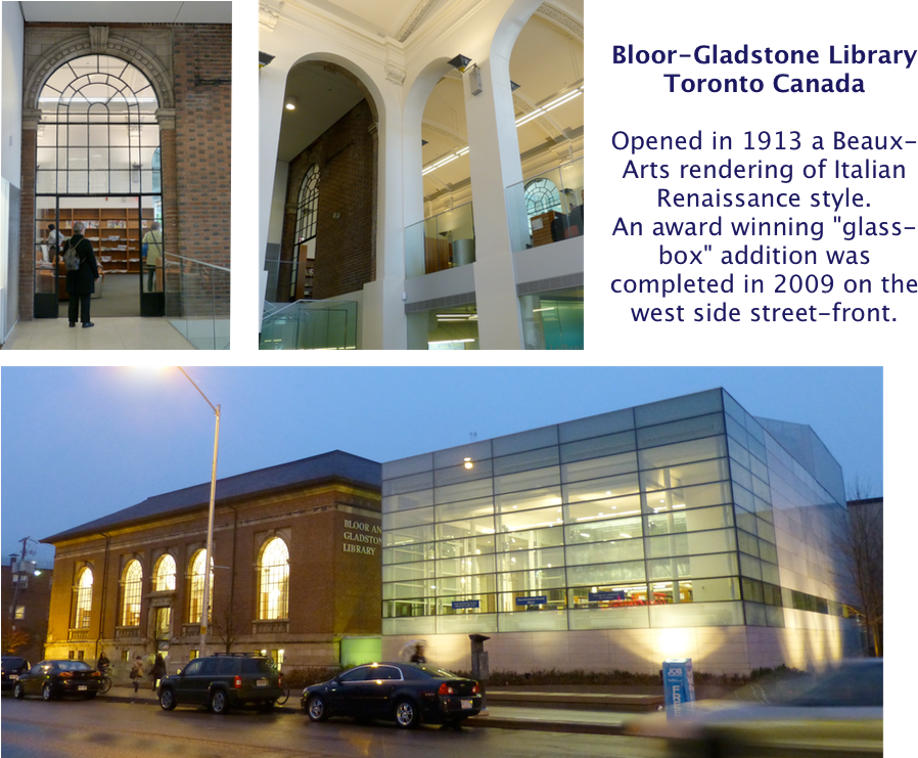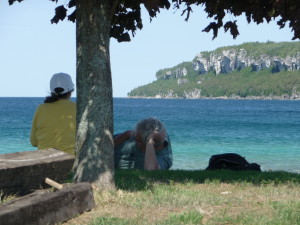Monthly Archives: April 2014
Toronto Reference Library
Heroes in situ
Heroes in situ , Don Alexander 2014
A photo montage of banners installed on lamp-posts in downtown St. Catharines (Niagara Canada).
The banners depict local heroes from creative arts, peace and social justice achievements. Backgrounds often relate to the subject’s role or medium.
The photo montage was donated to the artist run Niagara Artist’s Centre (NAC) for a fund raising sale, “Small Feats” a collection of 200 works one-foot square donated by artists. I shot the banners “in situ” over a six month period.
The banners were painted by Niagara area artists members of the CRAM gallery and/or NAC.
The Death and Life of Great American Cities, 50th Anniversary
Jane Jacobs – The Death And Life Of Great American Cities, 50 Years On. June 7, 2011 Niagara at Large online news
I wrote this piece with some thoughts about changing active transportation and street life in downtown St. Catharines, Canada.
Fifty years ago, we began to learn about city planning and living in a different way. The publication in 1961 of “Death and Life of Great American Cities” by Jane Jacobs turned a corner in the way we think about cities. The book still resonates with those who think and plan about the future directions of cities.
I first read the book, with wonder, about 1963. I began to imagine a different future for cities. Since that time, I have measured many of the city sights I see against the potentials that were held in Jane Jacob’s book and in her later publications about the economies of cities and regions.
In the mid-1990s Jane Jacobs and I became friends and our friendship continued until her death in 2006. I came to appreciate the way she thought about things. Her writing 50 years ago helped turn aside the linear way of thinking about traffic growth and subdivision sprawl. As time went on she described her ideas and writing as being interlaced like a spider’s web, “a web way of thinking”.

I produced an educational TV program about her entire work and the evolution of her ideas (Jane Jacobs: Urban Wisdom, 45 minutes, 2002). In a series of video interviews over the years, Jane reflected on her writing and her ideas. She called herself a non-fiction writer and resisted the “urban-guru” nomenclature.
In The Death and Life of Great American Cities, she felt the way streets worked was the key to understanding the potential of cities, “people weren’t just walking around or riding around with nothing on their minds but where they were doing all kinds of other things, by the way…the more you watched the more interesting and amazing connections you saw.
In the City of St. Catharines, for example, I have seen how a return to two-way traffic has again given pedestrians rights that had been lost to one-way traffic that was concentrating in getting through the area. It is interesting to watch cars now defer to pedestrians at crossings. A politeness has been achieved (mostly). Continue reading
Niagara Escarpment, Sacred Space
The Niagara Escarpment
Sacred Space
Presented at the Leading Edge Conference 2011
“Sustainable Tourism and Economic Development
in the Niagara Escarpment Biosphere Reserve.”
By Don Alexander, Commissioner, Niagara Escarpment Commission
The Niagara Escarpment is one of 562 Biosphere Reserves in the World. When the UNESCO MAB programme convened an International Workshop on the Importance of Sacred Natural Sites for Biodiversity Conservation, Biosphere Reserves were represented from all parts of the world EXCEPT North America and Western Europe. (1)
The distinction is made that “In many non-western societies traditional sacred areas fulfill functions similar to those of legally protected areas in “the west”. (1)
In traditional cultures the sacred is recognized in forests, individual trees, forest groves, waterfalls, springs, caves, prominent heights, glens and trails.
Consideration of the Niagara Escarpment as Sacred place strengthens the conservation ethic among growing numbers of people.
There is increasing opinion that a “sacred” out of the ordinary dimension will be necessary to give the environment the priority it needs to cope with pressures on the entire biosphere system.




